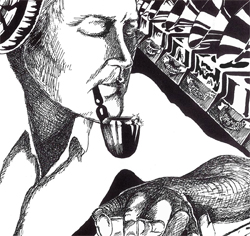
“I like to create a lot of crazy rhythms.”
“I mult the strings, and I usually use a little tape reverb. Just a little bit. Then afterwards in the mix. It depends, again, on what the mix is, what the tune is, what the arrangement is, whether they’re going to have echo or be dry, whether they’re going to have delayed echo. But I always put a little tape reverb on strings.”
Piano is approached according to the nature of the piece. In “Bridge Over Troubled Water” (the song), the piano was miked as would be a classical piano solo.
Three mikes were placed high and back, about six feet horizontally and six feet vertically. Condenser microphones were employed.
On a rock date however, the dynamics and presence of the piano are altered considerably, and dynamic microphones, with an occasional condenser, are placed in tight.
Listening to tracks Halee has done immediately impresses the listener that considerable innovation and work have gone into their making. Technique follows technique, building a complex stereo matte of interweaving and overlaid effects.
“Through the years I’ve put guitars in bathrooms, drums in bathrooms. Sometimes I phase the echo. You don’t know it’s being phased, but it is. I did that on “At The Zoo.”
I’ve put a couple of choruses of voices inside a bathroom or an echo chamber. Sometimes I put Dolbies in when I record and then take them out when I mix. I use a lot of tape reverb. Sometimes we use it to create our own rhythms. When I say “our”, I mean Simon and Garfunkel. We create our own rhythms in the mix.”
“That happened, for instance, on “Bridge Over Troubled Water” Hal Blaine is playing the bass drum, but he’s not playing the part you hear. There’s tape reverb on that bass drum.
Oddly enough, when we did it, we found that it would only work with a Scully four track. If we used another machine, because of the head distance, it was out of rhythm.”
“When you hear ‘Ba da Ba da da da da’, that’s not what he’s playing. He’s playing something like ‘Ba . . . da da’. Something like that. I’d have to listen to the original tape to get the exact figure he plays, but what you hear is different.”
“I do an awfully lot of that. I like to create a lot of crazy rhythms. A lot of times it’s out of rhythm, and you strike out. But I like to fool around and find out when it’s in rhythm, and then if it’s good, I’ll use it.
I’ll flip it in for a couple of bars, and take it out. Sometimes I’ll program it to another track, so it’ll answer itself.”
Halee has been asked to remix “Bridge Over Troubled Water” for quad, but so far he has been reluctant to do so. This might seem out of character for a man so willing to experiment and try new techniques, but Halee feels the quality of quad is not up to par yet.
Further, he says he’s like to get into miking and recording in quad, rather than just remixing.
“I don’t care for drums in back of me, or swishing around. There are phasing problems.”
It seems to me the direction everybody is going now is to have completely isolated tracks, so you can place things in definite positions. I’d like to get into room sound—dimension rather than direction. I feel a lot more experimentation is in order. Until I’ve done it, I’m not going to get into remixing old Simon and Garfunkel tunes. I want it to be good.”
What about the controversy over more tracks, 24, 32, or more?
“The more the merrier,” says Halee.
The technology doesn’t seem to frighten him. He plays with it until he knows it well enough to master it. Like a dancer, he finds new movements through experimentation, and learns them well before performing them for the public.
The spirit, coordination, and balance are all there. The engineer is an artist. Roy Halee dances with his fingers.
Take the PSW Photo Gallery Tour of audio equipment ads appearing in RE/P magazine, circa 1970
Editor’s Note: This is a series of articles from Recording Engineer/Producer (RE/P) magazine, which began publishing in 1970 under the direction of Publisher/Editor Martin Gallay. After a great run, RE/P ceased publishing in the early 1990s, yet its content is still much revered in the professional audio community. RE/P also published the first issues of Live Sound International magazine as a quarterly supplement, beginning in the late 1980s, and LSI has grown to a monthly publication that continues to thrive to this day.
Our sincere thanks to Mark Gander of JBL Professional for his considerable support on this archive project.
